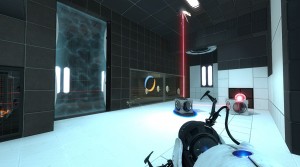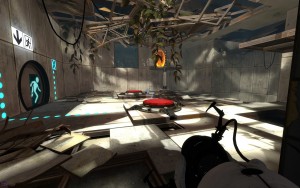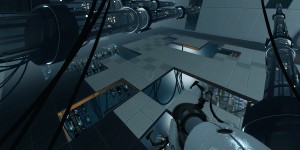Website: http://www.thinkwithportals.com/
Gameplay Demo: https://www.youtube.com/watch?v=aUiD2IyUpDI
 Portal 2 is a first-person puzzle-platform game developed by Valve and released in 2011. As the sequel to the much smaller but critically acclaimed Portal, Portal 2 expanded the world and the scope of puzzles that the player had to tackle, but still maintaining the core gameplay mechanic of the original game. The player has a “gun” that shoots two different portals that are connected to one another. Whatever goes in the first one will come out of the second one. The game is structured through a series of “test chambers”, each of which has an entrance and an exit, and the player has to figure out how to use his portal gun to get himself out of each chamber. As the game progresses, the complexity of the puzzles gradually increases as more mechanics are introduced.
Portal 2 is a first-person puzzle-platform game developed by Valve and released in 2011. As the sequel to the much smaller but critically acclaimed Portal, Portal 2 expanded the world and the scope of puzzles that the player had to tackle, but still maintaining the core gameplay mechanic of the original game. The player has a “gun” that shoots two different portals that are connected to one another. Whatever goes in the first one will come out of the second one. The game is structured through a series of “test chambers”, each of which has an entrance and an exit, and the player has to figure out how to use his portal gun to get himself out of each chamber. As the game progresses, the complexity of the puzzles gradually increases as more mechanics are introduced.
Elemental Tetrad
- Aesthetics – Portal 2 has a very clean aesthetic with relatively little variation in colour schemes and very few superfluous effects (e.g. particle or lighting effects). This helps to 1) reinforce the industrial setting of the game, and 2) significantly improves clarity of the puzzles. The puzzles faced by the player can become very complex in the later levels, and the clarity of the aesthetics provides the player with all the information he needs to solve the puzzle, allowing him to focus on tacking the puzzle.
- Story – The main aim of the player is to escape the facility, and while the protagonist remains silent throughout the game, she is accompanied by various announcers and non-playable characters that humorously convey the story. Various objects are also placed around the levels in specific ways to tell the story in more subtle manners.
- Technology – The physics system in the Source engine is very robust and allows for interesting puzzle design, as objects maintain their momentum when going through portals.
- Mechanics – The core mechanic of portals is unique and interesting by itself, but more mechanics are introduced throughout the game (e.g. new objects that can pass through the portal or new environments). While the mechanics seem simple, they are combined together in many different ways, resulting in brilliant level and puzzle design.
Lens of Essential Experience
While teleporting through portals is the game’s core mechanic, its “essential experience” is allowing the player to feel like they are outsmarting the various antagonists of the game, who tend to be various AIs that are intent on trapping the player in the facility or killing the protagonist. The antagonists consistently taunt the player (albeit in humorous ways), suggesting that the player is too incapable to escape the facility. Furthermore, the puzzles players are presented with often seem impossibly complex at first glance, causing the player to feel extremely smart and satisfied with himself once he has completed each level. On closer inspection, the levels are actually designed in such a way that the player is subtly guided towards the solution (e.g. through particular placement of certain objects or emphasising certain parts of the level through aesthetics), while simultaneously making the player feel like he is discovering the solution by himself. All these factors result in a puzzle game that is especially satisfying to complete and hence extremely fun for the player.
Lens of Character
The game has great characterisation even though there are so few characters in it. GLaDOS and Wheatley are AIs that both act as companion and antagonist to the player throughout the game, switching roles mid-game. They are extremely talkative characters, with humorous dialogue filling practically the entire game, even while the player is solving a puzzle. This is unique in that character development and storytellingis fused with the gameplay, instead of being separate aspects like in other games where gameplay is interrupted by cutscenes for narrative purposes. Perhaps the weakest part of Portal 2’s characters is the protagonist herself, Chell. She remains silent throughout the entire game, and very little can be gleaned about Chell from whatever dialogue there is in the game. She feels like a boring, blank slate in some ways. However, this does seem to be Valve’s style, as they also make use of a silent protagonist in their other major game, Half-Life.
Lens of Simplicity/Complexity
In my opinion, Portal 2 nails the fine balance between simplicity and complexity. It starts off with a deceptively simple mechanic and slowly introduces the player to new ways to use the portal gun (e.g. falling through a portal from high up to gain speed). As the game progresses, other mechanics are introduced that interact with the portal gun (e.g. cubes that can be thrown through portals), leading to more complex and interesting puzzles. Hence, there is an “emergent complexity” to the puzzles as the player is introduced to new mechanics incrementally and methodically. Furthermore, while the mechanics are extremely simple to understand, the levels are designed in very unique ways that forces the player to use these simple mechanics in many complex and interesting ways, leading to more complicated and thus satisfying puzzles for the player to complete.  Observations while watching a friend
Observations while watching a friend
Lens of Essential Experience
My friend’s essential experience with the game was near identical to mine, in that she found it much more fun than the average puzzle game and was also highly satisfied with herself every time she completed a level. She also felt that the game does a very good job of “making you feel very smart”.
Lens of Simplicity/Complexity
My friend was extremely excited and intrigued by the portal mechanic in the game, proving that the simplicity of the portal gun was a very interesting mechanic even for less experienced gamers. Furthermore, usage of the portal gun was intuitive for my friend, and she was able to easily complete the early stages without being too confused over how the portal mechanic worked. This once again shows how Valve managed to nail the “simplicity” element of game design, whereby the game is intuitive to play but still challenges the player to complete difficult puzzles.
Lens of Control
My friend does not have much experience with first-person games, leading to some difficulty in using the standard WASD controls to move the character efficiently. While this did not hinder her from completing the puzzles, it certainly did cause frustration at some points where tight control of the character was necessary. However, it is difficult to see how Valve could have made the controls friendlier for inexperienced gamers, as the WASD controls have been the standard control scheme for first-person games for more than a decade now.
Lens of Character
While I personally found the characters in the game extremely interesting and entertaining, my friend did not care much for their dialogue. Many of the jokes that I found funny did not hit home for my friend, as she either didn’t understand what they were saying or simply didn’t find it very funny. Humour in games is a relatively rare occurrence. Most games tend to tell “serious” stories, and those that do not often find humour in ridiculous premises or simply have slapstick humour. Trying to include more “highbrow” humour is a challenge in games due to everyone’s differing sense of humour. There is also a lack of control over the specific timing of joke delivery (due to the interactive nature of games), which can often make or break a joke. The dialogue from Western games often leans towards Western sensibilities as well, making it harder for the international audience to fully grasp the nuances at times. When done right, humour in games can vastly improve the player’s experience, partly due to how rare it appears in games. However, it is challenging to write great dialogue that appeals to all gamers.
Analysis
Both my friend and I thoroughly enjoyed playing Portal 2, and for similar reasons. We both experienced the “essential experience” that I believe Valve had intended, as completing puzzles in Portal 2 is just so much more satisfying than completing other puzzle games.
The main differences in our experiences were in ease of controlling the character and the degree to which we enjoyed the dialogue and story.
As I am very experienced with first-person games, it never occurred to me that the controls could be a stumbling block for some players. My friend is more accustomed to games where the character being controlled can be seen, or games which have a cursor on-screen (e.g. real time strategy games). However, using a different perspective would change the overall “feel” of the game, and even though using a first-person perspective might alienate some players, I feel that it is too closely linked to the essential experience for it to be changed.
As for the humour and dialogue in general, such things can be very subjective, making it relatively difficult to determine what should be the “best” way to write dialogue and stories for games. Even though my friend did not find the dialogue to be very funny, we both agreed that the way the story is presented is very interesting, as the game has a lot of character even though the player sees very few characters throughout the game. Using various announcers as the primary characters in the game is an interesting technique of storytelling in games, and one that is seldom seen. Portal 2 proves that when done well, this technique can be very effective.
On the whole, both my friend and I agreed that Valve succeeded in creating an extremely fun and unique puzzle game that manages to mesh gameplay and storytelling in an elegant fashion. Of course, the game seems to be lacking in certain departments (e.g. bland graphics and the protagonist’s non-existent personality). However, these seem to be calculated design decisions instead of oversights. While these are usually signs of bad game design, they contribute to the player’s experience in positive ways in Portal 2, adding to the experience rather than detracting from it. In my opinion, Portal 2 is the pinnacle of great game design as every aspect of it was thoroughly thought out, and it is simply great fun to play.
Wong Kang-An
A0097091Y

